Introduction
Chandanasava, also known as Chandanasavam or Sandalwood Ayurvedic Fermented Liquid, is a traditional Ayurvedic formulation that has been used for centuries in India. This herbal preparation is renowned for its therapeutic properties and is widely used in the treatment of various ailments.
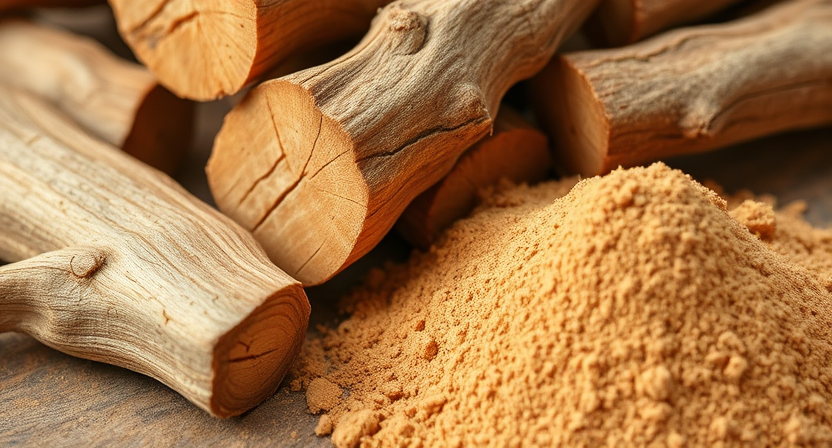
It is a polyherbal formulation, meaning it is composed of multiple herbs, with sandalwood (Chandana) being the primary ingredient. This article delves into the origins, composition, preparation, therapeutic benefits, and modern applications of Chandanasava, providing a comprehensive understanding of this ancient Ayurvedic elixir.
Table of Contents
Historical Background
Origins in Ayurveda
Ayurveda, the ancient Indian system of medicine, dates back over 5,000 years. It is based on the principle of maintaining a balance between the body, mind, and spirit to achieve optimal health. Ayurvedic texts, such as the Charaka Samhita and Sushruta Samhita, describe various herbal formulations, including Chandanasava, which have been used for centuries to treat a wide range of health conditions.
Significance of Sandalwood
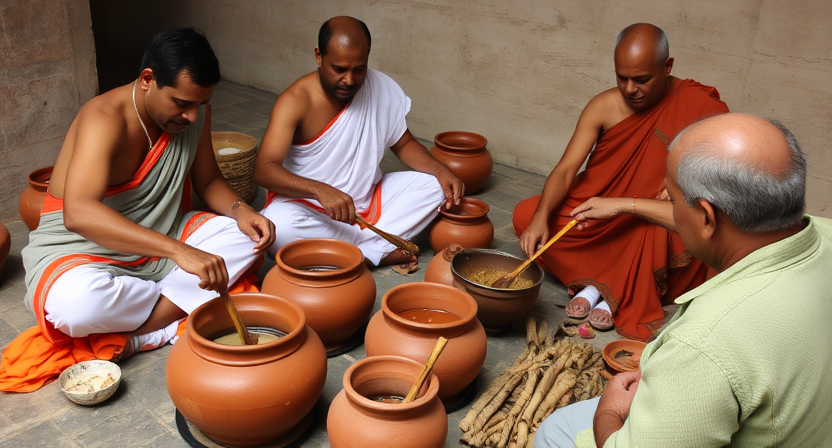
Sandalwood, or Chandana, holds a special place in Ayurveda due to its cooling, soothing, and aromatic properties. It is considered one of the most sacred woods in India and is often used in religious ceremonies, meditation, and traditional medicine. The use of sandalwood in Chandanasava is believed to enhance the formulation’s efficacy, particularly in treating conditions related to heat and inflammation.
Composition of Chandanasava
It is a complex formulation that includes a variety of herbs, each contributing to its therapeutic effects. The primary ingredient is sandalwood, but the formulation also contains other herbs, spices, and natural substances. The exact composition may vary slightly depending on the manufacturer, but the following are some of the key ingredients commonly found in Chandanasava:
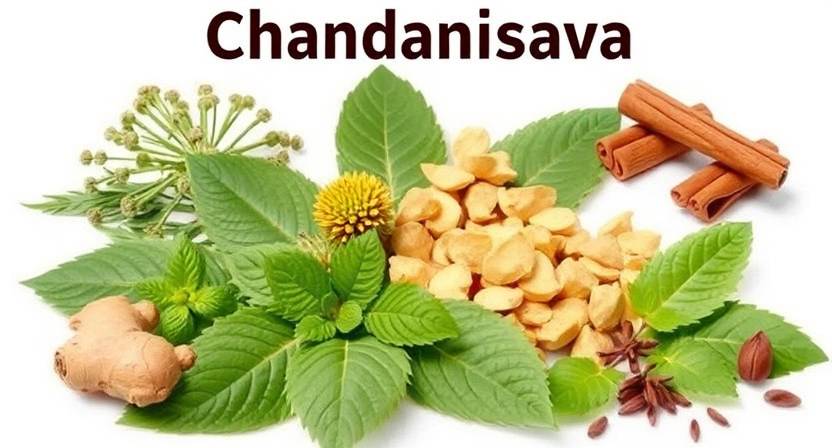
Primary Ingredients
- Sandalwood (Chandana): The main ingredient, known for its cooling and anti-inflammatory properties.
- Water: Used as the base for the fermentation process.
- Jaggery or Honey: Acts as a natural sweetener and provides energy.
- Dhataki (Woodfordia fruticosa): A flowering plant used to initiate the fermentation process.
- Haritaki (Terminalia chebula): A fruit known for its detoxifying and rejuvenating properties.
- Bibhitaki (Terminalia bellirica): Another fruit used for its astringent and anti-inflammatory effects.
- Amalaki (Emblica officinalis): Also known as Indian gooseberry, it is rich in vitamin C and antioxidants.
- Mustaka (Cyperus rotundus): A herb used for its digestive and anti-inflammatory properties.
- Vidanga (Embelia ribes): Known for its anthelmintic (anti-parasitic) properties.
- Pippali (Piper longum): A type of long pepper used for its digestive and respiratory benefits.
- Ginger (Zingiber officinale): Known for its anti-inflammatory and digestive properties.
- Cinnamon (Cinnamomum verum): Used for its warming and digestive effects.
- Cardamom (Elettaria cardamomum): Known for its aromatic and digestive properties.
- Clove (Syzygium aromaticum): Used for its antimicrobial and analgesic properties.
- Nutmeg (Myristica fragrans): Known for its calming and digestive effects.
Secondary Ingredients
In addition to the primary ingredients, It may also contain other herbs and natural substances, such as:
- Ashwagandha (Withania somnifera): Known for its adaptogenic and rejuvenating properties.
- Shatavari (Asparagus racemosus): Used for its nourishing and rejuvenating effects, particularly in women.
- Guduchi (Tinospora cordifolia): Known for its immune-boosting and detoxifying properties.
- Licorice (Glycyrrhiza glabra): Used for its anti-inflammatory and soothing effects.
- Black Pepper (Piper nigrum): Known for its digestive and bioavailability-enhancing properties.
Preparation of Chandanasava
The preparation of It is a meticulous process that involves several steps, including the selection of ingredients, fermentation, and aging. The traditional method of preparation is as follows:
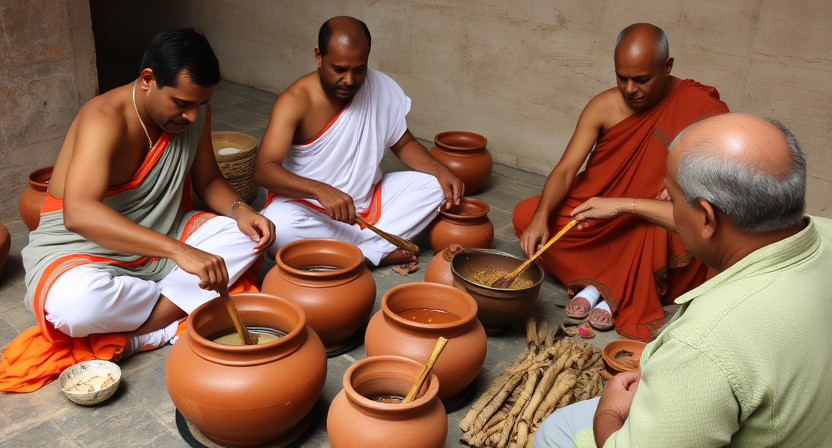
Step 1: Selection of Ingredients
The first step in preparing It is the selection of high-quality ingredients. The herbs and spices are carefully chosen based on their potency, freshness, and purity. Sandalwood, being the primary ingredient, is selected for its aroma and therapeutic properties.
Step 2: Preparation of the Decoction
The selected herbs are then cleaned and dried. A decoction is prepared by boiling the herbs in water until the liquid is reduced to a concentrated form. This decoction serves as the base for the fermentation process.
Step 3: Fermentation
The decoction is then mixed with jaggery or honey, which acts as a natural sweetener and provides the necessary sugars for fermentation. Dhataki flowers are added to initiate the fermentation process. The mixture is then transferred to a clean, airtight container and left to ferment for a specific period, usually ranging from 15 to 30 days. During this time, the mixture undergoes a natural fermentation process, resulting in the formation of alcohol and other beneficial compounds.
Step 4: Filtration and Aging
After the fermentation process is complete, the mixture is filtered to remove any solid particles. The liquid is then transferred to another container and left to age for a few weeks to several months. Aging allows the flavors to mature and the therapeutic properties to develop fully.
Step 5: Bottling and Storage
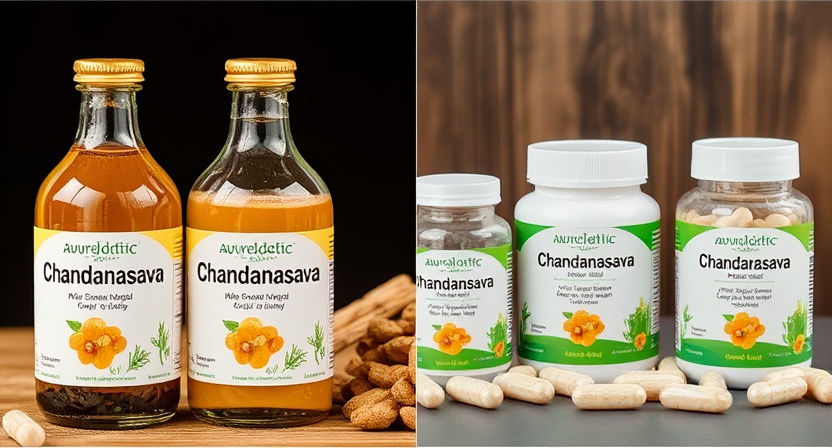
Once the aging process is complete, the Chandanasava is bottled in clean, sterilized containers. It is then stored in a cool, dark place to preserve its potency and shelf life.
Therapeutic Benefits of Chandanasava
It is known for its wide range of therapeutic benefits, which are attributed to the synergistic effects of its herbal ingredients. Some of the key benefits include:
1. Digestive Health
It is widely used to promote digestive health. It helps in the digestion of food, reduces bloating, and alleviates symptoms of indigestion, such as gas and acidity. The herbs in Chandanasava, such as ginger, pippali, and cardamom, stimulate the digestive fire (Agni) and improve the absorption of nutrients.
2. Anti-inflammatory Properties
Sandalwood, the primary ingredient in It , is known for its potent anti-inflammatory properties. It helps in reducing inflammation in the body, making it beneficial for conditions such as arthritis, gout, and other inflammatory disorders.
3. Cooling Effect
It has a cooling effect on the body, making it particularly useful in hot climates or during the summer months. It helps in reducing body heat, preventing heat-related conditions such as heatstroke, and soothing conditions like sunburn and skin rashes.
4. Detoxification
The herbs in It , such as haritaki, bibhitaki, and amalaki, are known for their detoxifying properties. They help in eliminating toxins from the body, improving liver function, and promoting overall health.
5. Immune Support
It contains herbs like ashwagandha, guduchi, and licorice, which are known for their immune-boosting properties. Regular consumption of Chandanasava can help in strengthening the immune system, making the body more resistant to infections and diseases.
6. Respiratory Health
It is beneficial for respiratory health, particularly in conditions like asthma, bronchitis, and cough. The herbs in It , such as pippali and ginger, help in clearing the respiratory tract, reducing mucus, and improving breathing.
7. Stress Relief
It has a calming effect on the mind and body, making it useful in managing stress and anxiety. The herbs in It , such as sandalwood and nutmeg, help in relaxing the nervous system, promoting mental clarity, and improving sleep quality.
8. Skin Health
Sandalwood is known for its skin-soothing and healing properties. It can be used both internally and externally to improve skin health. It helps in reducing acne, soothing skin irritations, and promoting a clear and radiant complexion.
9. Urinary Health
Chandanasava is beneficial for urinary health, particularly in conditions like urinary tract infections (UTIs) and kidney stones. The herbs in Chandanasava help in reducing inflammation, promoting urine flow, and flushing out toxins from the urinary system.
10. Rejuvenation and Longevity
It is considered a Rasayana (rejuvenative) in Ayurveda, meaning it promotes longevity and overall well-being. The combination of herbs in It helps in nourishing the body, improving vitality, and slowing down the aging process.
Modern Applications of Chandanasava
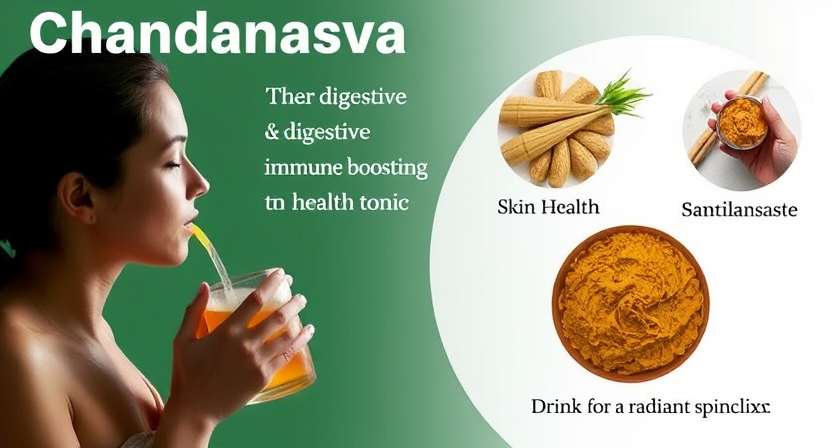
While It has been used for centuries in traditional Ayurvedic medicine, it has also found a place in modern healthcare. Today, It is available in various forms, including liquid extracts, capsules, and tablets, making it more accessible to a wider audience. Some of the modern applications of Chandanasava include: Check Out Here
1. Integrative Medicine
It is increasingly being used in integrative medicine, where it is combined with conventional treatments to enhance their efficacy and reduce side effects. For example, Chandanasava may be used alongside anti-inflammatory drugs to reduce inflammation and promote healing.
2. Functional Foods and Beverages
It is being incorporated into functional foods and beverages, such as herbal teas, tonics, and health drinks. These products are marketed for their health benefits, including digestive support, immune boosting, and stress relief.
3. Skincare Products
The skin-soothing properties of It have led to its inclusion in various skincare products, such as creams, lotions, and serums. These products are designed to reduce inflammation, soothe skin irritations, and promote a healthy complexion.
4. Dietary Supplements
Chandanasava is available in the form of dietary supplements, such as capsules and tablets, which are convenient for those who prefer not to consume the liquid form. These supplements are marketed for their digestive, anti-inflammatory, and immune-boosting properties.
5. Research and Development
There is growing interest in the scientific community to study the therapeutic properties of It and its individual ingredients. Research is being conducted to understand the mechanisms of action, efficacy, and safety of Chandanasava in various health conditions.
Safety and Precautions
While It is generally considered safe for most people, there are some precautions to keep in mind:
- Alcohol Content: It is a fermented product and contains a small amount of alcohol. Individuals who are sensitive to alcohol or those who are pregnant or breastfeeding should consult a healthcare professional before using It .
- Allergies: Some individuals may be allergic to certain herbs or ingredients in Chandanasava. It is important to check the ingredient list and consult a healthcare professional if you have any known allergies.
- Dosage: The dosage of It may vary depending on the individual’s age, health condition, and the form of the product. It is important to follow the recommended dosage on the product label or consult a healthcare professional for guidance.
- Drug Interactions: It may interact with certain medications, particularly those that affect the liver or have sedative effects. It is important to consult a healthcare professional if you are taking any medications.
- Quality: The quality of It can vary depending on the manufacturer. It is important to choose a reputable brand that follows good manufacturing practices and uses high-quality ingredients.
Conclusion
It is a time-tested Ayurvedic formulation that offers a wide range of therapeutic benefits. Its unique combination of herbs, particularly sandalwood, makes it a powerful remedy for various health conditions, from digestive issues to skin problems. As modern science continues to explore the potential of traditional medicines, It is likely to gain even more recognition for its health-promoting properties. Whether used in its traditional form or as part of modern healthcare, It remains a valuable tool in the pursuit of holistic health and well-being.
In conclusion, It is not just a medicinal preparation; it is a testament to the wisdom of ancient Ayurveda and its ability to provide natural, effective solutions for modern health challenges. As we continue to explore and understand the benefits of this ancient elixir, it is essential to approach its use with respect, knowledge, and a commitment to preserving the rich heritage of Ayurvedic medicine
FAQs About Chandanasava and Related Formulations
- What are the side effects of Chandanasava?
While generally considered safe, potential side effects of Chandanasava include mild digestive upset or loose stools. Allergic reactions to any of the ingredients are also possible. Due to the presence of alcohol, this also needs to be considered. - What is Chandanasava syrup used for?
Chandanasava is traditionally used to address urinary tract infections (UTIs), reduce inflammation, purify blood, support skin health, and act as a mild diuretic. It helps in balancing the Pitta dosha by providing a cooling effect. - How do you drink Chandanasava?
Chandanasava is typically taken orally, diluted with an equal quantity of water. The usual dosage is 10-20 ml (2-4 teaspoons) twice daily after meals, or as directed by a qualified Ayurvedic practitioner. - Does Chandanasava contain alcohol?
Yes, Chandanasava is an asava, a self-generated alcoholic preparation made through fermentation. The alcohol content is typically in the range of 5-10%. - What are the ingredients in Chandanasava?
Key ingredients include Chandana (sandalwood), Rakta Chandana (red sandalwood), Sugandhabala, Usheer, Gambhari, Musta, Rasna, Dhataki flowers, Lodhra, Nagkesar, Katuka, jaggery and sugar. - What is the alcohol content of Chandanasava?
The alcohol content of Chandanasava typically ranges between 5-10% due to the natural fermentation process involved in its preparation. - What is Chandanasava syrup in Planet Ayurveda?
Chandanasava syrup from Planet Ayurveda is the same traditional Ayurvedic formulation made by this specific brand. - How do you drink Chandanasava?
Chandanasava is typically taken orally, diluted with an equal amount of water. It is usually taken after meals. The dosage is usually 10-20 ml twice a day or as directed by your healthcare provider. - What is Multani Chandanasava used for?
Multani Chandanasava is another brand of the traditional Ayurvedic formulation. It is used for the same conditions as mentioned earlier such as to treat urinary and skin problems and reduce inflammation. - What is Chandanadi syrup used for?
Chandanadi syrup is another formulation with similar ingredients with the main ingredient being Chandana. It is used for its cooling, diuretic and anti-inflammatory effects. - What is Chandan syrup used for?
Chandan syrup is a general term for syrups that contain sandalwood as the main ingredient. They are typically used for their cooling and soothing properties, often in summer to reduce body heat. - What is Chandanadi Kashayam used for?
Chandanadi Kashayam is a traditional Ayurvedic decoction containing Chandana as the main ingredient. It is used for its cooling and anti-inflammatory properties, often for urinary and skin related conditions. - Is Guggul good for the kidneys?
Guggul is an Ayurvedic herb that has anti-inflammatory properties and supports overall health. It may indirectly benefit kidney function, but it is not a direct treatment for kidney problems. Those with kidney problems should consult with a healthcare provider before using it. - What is Gokshuradi Guggul used for?
Gokshuradi Guggul is an Ayurvedic formulation that combines Guggul with Gokshura and other herbs. It is used to treat urinary issues, kidney stones, and is beneficial for prostate health. - What is Ashokarishta?
Ashokarishta is a traditional Ayurvedic formulation primarily used to address various gynecological conditions, particularly menstrual disorders and uterine health. - Does Ashokarishta have alcohol?
Yes, Ashokarishta is an arishta, which is a self-generated alcoholic preparation made through fermentation and contains a certain amount of alcohol. - How to use Draksharishta?
Draksharishta is taken orally, usually after meals, often diluted with water. It is used as a digestive tonic, for improving appetite and also to reduce weakness. - Is Draksharishta good for anemia?
While Draksharishta is not a primary treatment for anemia, it helps as a general tonic for digestive health and can improve overall strength. There are other formulations like Lohasava which are used specifically for treating anemia. - What is Sarivadyasava used for?
Sarivadyasava is a traditional Ayurvedic formulation used as a blood purifier, for skin diseases, and for its cooling properties. - What is Saribadyasavam used for?
Saribadyasavam is another name for Sarivadyasava, referring to the same traditional Ayurvedic formulation used for skin conditions, blood purification, and cooling. - What is Kumaryasava used for?
Kumaryasava is an Ayurvedic formulation with Kumari (Aloe vera) as the main ingredient, and is used for digestive issues, liver problems, and menstrual irregularities. It helps in balancing Pitta. - What is Rohitakarishta?
Rohitakarishta is a traditional Ayurvedic formulation that is used for liver disorders and as a hepatoprotective. - When should I drink Lohasava?
Lohasava is usually taken after meals, or as directed by a healthcare practitioner. It is often used to treat anemia. - What is the use of kanakasava?
Kanakasava is an Ayurvedic formulation used for respiratory issues like cough, and for improving overall lung health. - How do you use Punarnavasavam?
Punarnavasavam is traditionally used after meals. It is used for treating fluid retention and is often used for kidney conditions. - How to drink Dhanwantharam Kashayam?
Dhanwantharam Kashayam is a herbal decoction traditionally taken before meals, unless otherwise directed by the physician. It is often used to manage Vata related disorders. - How do you use Chandanadi Thailam?
Chandanadi Thailam is an Ayurvedic oil that is for external use. It is used for its cooling and anti-inflammatory properties, mainly for skin diseases. - What is Dhanwantharam Gulika used for?
Dhanwantharam Gulika is an Ayurvedic formulation used to treat Vata disorders and for strengthening the body. It is used to manage general weakness, joint pain, back pain, etc. - Is Chandraprabha Vati safe?
Chandraprabha Vati is generally considered safe when taken as directed. However, those with specific health conditions, should consult their health provider before starting this formulation. - Is Chandraprabha Vati good for periods?
Chandraprabha Vati is traditionally used to manage menstrual irregularities, but should be used under the guidance of a healthcare professional. - Is Chandraprabha Vati good for the liver?
While some ingredients in Chandraprabha Vati may have liver-protective properties, it is not primarily a liver tonic. If you are looking to manage liver disorders, please consult a physician. - What is Chandraprabha tablet used for?
Chandraprabha Vati tablet is a traditional Ayurvedic formulation used for urinary problems, diabetes, and various other health conditions. - What is Chandraprabha age?
It is a reference to Chandraprabha Vati. Chandraprabha is a traditional Ayurvedic formulation that has been used for a long period. However, individual results and benefits from its use vary and this is not a reference to an age. - Which Syrup reduces body heat?
Several Ayurvedic syrups with cooling properties can help reduce body heat, including Saribadyasava, Usheerasava and Chandan syrup. - What is epilepsy syrup used for?
Many modern medications are used for managing epilepsy and also some Ayurvedic formulations with Brahmi and other nervine herbs. A qualified medical professional should be consulted for epilepsy and other neurological issues. - Is Arogyavardhini Vati safe?
Arogyavardhini Vati is generally safe when taken as directed by a healthcare practitioner. However, it should be avoided by people with severe kidney, or heart issues and also during pregnancy and breastfeeding. - How to reduce protein in urine by Ayurveda?
Ayurvedic treatment for reducing protein in urine involves dietary changes, lifestyle modifications, and herbal formulations. You must always consult with a health professional for guidance.
